Live Eagle Cam
http://www.infotecbusinesssystems.com/wildlife/
This is pretty neat!
 I learned of Tiffany McPherson and her dog Knuckles' via a dogster.com email I received from a fellow BSL fighter up in Ontario, Canada. Tiffany had emailed her seeking advice from anyone who might help her save the life of her beloved Pittie, Knuckles. My friend forwarded Tiffany's email to me, as both Tiffany and I live in Northern California. Over the last few days, I've come to know Tiffany through the many emails we've exchanged regarding Knuckles' desperate situation.
I learned of Tiffany McPherson and her dog Knuckles' via a dogster.com email I received from a fellow BSL fighter up in Ontario, Canada. Tiffany had emailed her seeking advice from anyone who might help her save the life of her beloved Pittie, Knuckles. My friend forwarded Tiffany's email to me, as both Tiffany and I live in Northern California. Over the last few days, I've come to know Tiffany through the many emails we've exchanged regarding Knuckles' desperate situation. As I mentioned, Knuckles' execution was scheduled for today but, miraculously, Tiffany found an attorney to take her case. Yesterday afternoon, her attorney filed a court petition for a stay of destruction, giving poor Knuckles' a last-minute reprieve. In addition to the stay, the petition also requests a new hearing for Knuckles, to be held at the Solano County Superior Courthouse. The court date has not been set yet and is not expected to happen for at least another two weeks. It is what we in the dog community do in these next two weeks that may very well determine whether Knuckles lives or dies. I cannot stress the urgency of the situation enough; Knuckles' fate literally hangs in the balance.
As I mentioned, Knuckles' execution was scheduled for today but, miraculously, Tiffany found an attorney to take her case. Yesterday afternoon, her attorney filed a court petition for a stay of destruction, giving poor Knuckles' a last-minute reprieve. In addition to the stay, the petition also requests a new hearing for Knuckles, to be held at the Solano County Superior Courthouse. The court date has not been set yet and is not expected to happen for at least another two weeks. It is what we in the dog community do in these next two weeks that may very well determine whether Knuckles lives or dies. I cannot stress the urgency of the situation enough; Knuckles' fate literally hangs in the balance.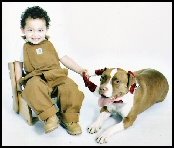 As of today, April 21st, Knuckles has been confined for 33 long days to a small cage at the Solano County Animal Services facility, and will continue languishing there for at least another two weeks whilst she awaits her new court date. Most of you probably know how hard long confinement without exercise and social interaction is on a dog's physical and mental well-being. That is why it is so important to win Knuckles' freedom as soon as is humanly possible. I believe we can achieve this through an action plan that will alert both the media and public alike to Knuckles' desperate situation.
As of today, April 21st, Knuckles has been confined for 33 long days to a small cage at the Solano County Animal Services facility, and will continue languishing there for at least another two weeks whilst she awaits her new court date. Most of you probably know how hard long confinement without exercise and social interaction is on a dog's physical and mental well-being. That is why it is so important to win Knuckles' freedom as soon as is humanly possible. I believe we can achieve this through an action plan that will alert both the media and public alike to Knuckles' desperate situation. 1. The Solano County Animal Control Services facility. Please call, email and/or write to them to express your support for Knuckles' release and for the fair and unbiased treatment of Pit Bulls and their mixes. Call every day, if you can. We must bombard them with our words and voices in order to force their serious attention to this important issue.
1. The Solano County Animal Control Services facility. Please call, email and/or write to them to express your support for Knuckles' release and for the fair and unbiased treatment of Pit Bulls and their mixes. Call every day, if you can. We must bombard them with our words and voices in order to force their serious attention to this important issue. 1. The case background. This page details the events and misunderstandings which led to Knuckles' impoundment and death sentence.
1. The case background. This page details the events and misunderstandings which led to Knuckles' impoundment and death sentence. Capone, a 2-year-old pit bull owned by Garry Laffredi of Waukegan, is recovering after being attacked by a Pomeranian.
Capone, a 2-year-old pit bull owned by Garry Laffredi of Waukegan, is recovering after being attacked by a Pomeranian.
By Dan Moran
Staff Writer
WAUKEGAN — Animal Warden Tina Fragassi said she was not surprised when her office fielded a report Thursday about a 10-pound Pomeranian attacking an 80-pound pit bull.
"They stand their ground, those little dogs," she said, describing how one of her relatives has a small mixed-breed dog that charges her own pit bull and Labrador every time the three dogs cross paths.
That's basically what happened Thursday afternoon at a Sunset Avenue apartment complex, where Garry Laffredi said he was walking his 2-year-old pit bull Capone when a neighbor's Pomeranian came running at them.
"(Capone's) not a bad guy. He's real friendly. He's people friendly," Laffredi said. "He loves other dogs. (But) this little Pomeranian ran out and starts biting him on the foot."
Pomeranians, which are classified as Toy dogs by the American Kennel Club, can be as small as three pounds and resemble a fox in appearance, generally having a bushy orange coat and pointed ears.
Laffredi said the Pomeranian bit Capone's foot hard enough "to draw blood" also managed to nick Capone on the top of the head as he tried to pull the pit bull away on a leash.
Eventually, Laffredi said, Capone "grabbed the dog and more or less set him off to the side" before the two dogs were separated.
Citations issued
Animal control officers called to the scene reported that Laffredi told them the Pomeranian also bit him on the hand two weeks ago, but he chose not to report it at the time. The owner of the Pomeranian was issued four citations for Thursday's incident — failure to prevent a dog bite, owning a dog running at large, not possessing a dog license and not having updated rabies shots.
Each citation comes with a $25 fine if paid within 30 days. Fragassi said in cases of a first-time animal-to-animal bite with no current rabies shots, the animal is not seized but the owner must have the dog checked by a veterinarian for rabies after 10 days.
The owner of the Pomeranian declined to speak about the incident, describing it as an unfortunate episode that she wanted to put behind her.
 (LOUISVILLE) -- Three young children are being honored by the Louisville Kennel Club, after they saved the life of a dog left for dead. Unfazed by the horrid conditions, or that the animal abandoned was a pit bull, these three "canine heroes" learned there's more to a dog, than meets the eye. WAVE 3 Investigator Eric Flack has their story.
(LOUISVILLE) -- Three young children are being honored by the Louisville Kennel Club, after they saved the life of a dog left for dead. Unfazed by the horrid conditions, or that the animal abandoned was a pit bull, these three "canine heroes" learned there's more to a dog, than meets the eye. WAVE 3 Investigator Eric Flack has their story.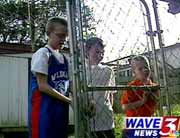 So they boys weren't bothered when the animal that needed saving was a pit bull named "Bush."
So they boys weren't bothered when the animal that needed saving was a pit bull named "Bush." "It sounded like a screeching kind of bark," Nick remembered.
"It sounded like a screeching kind of bark," Nick remembered. Bush had been abandoned for weeks. His owners moved out and just left him behind.
Bush had been abandoned for weeks. His owners moved out and just left him behind.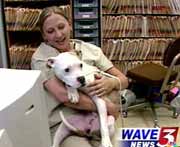 For two weeks, the boys cared for bush behind their parents' back. But the dog was still losing weight -- from worms as it turned out. So the boys finally came clean, with just one request: don't let them put Bush to sleep.
For two weeks, the boys cared for bush behind their parents' back. But the dog was still losing weight -- from worms as it turned out. So the boys finally came clean, with just one request: don't let them put Bush to sleep.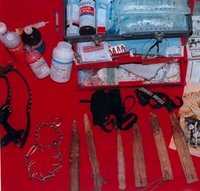 Some of the items used in underground dog fighting
Some of the items used in underground dog fighting

 “If we target one breed, fighters will just switch," says Small. "It will make other dogs more aggressive.”
“If we target one breed, fighters will just switch," says Small. "It will make other dogs more aggressive.”Fear of dangerous dogs, not dangerous breeds
Small dogs are among some of the most feared
Josée Guillemette
 Claudio, mixed terrier
Claudio, mixed terrier “Many of the big dogs are trained because people don’t tolerate a big dog that bites,” she said. “Owners of bigger dogs, most of the time, train them better because they just know they have to.”
“Many of the big dogs are trained because people don’t tolerate a big dog that bites,” she said. “Owners of bigger dogs, most of the time, train them better because they just know they have to.” Today, MacPherson has only two dogs – the purebred Texas and Prudence, a half-blind Cairn terrier. But for almost twenty years, MacPherson was one of the top rottweiler breeders in Southern Ontario.
Today, MacPherson has only two dogs – the purebred Texas and Prudence, a half-blind Cairn terrier. But for almost twenty years, MacPherson was one of the top rottweiler breeders in Southern Ontario. Now retired, MacPherson has scrapbooks filled with mementos from those days, when she and her husband bred and raised the dogs on their pig farm in Ankona. Along with dozens of photographs, she also has the certifications from the Canadian Kennel Club (CKC) for all of her purebred rottweilers.
For two decades, Helen MacPherson was a registered rottweiler breeder. But many breeders are not certified by the CKC, and it’s these “backyard breeders” who are now causing concern – both to legitimate breeders and the public alike.
Irresponsible breeding
In most cases, irresponsible backyard breeding means that litters of unwanted puppies end up in pounds and animal shelters.
But when it comes to rottweilers, akitas, and other so-called “dangerous dogs,” backyard breeding can turn into a deadly problem.
Link: Pit bull ban won’t stop dog fighting, experts say
The CKC has a stern code of ethics designed to curtail unregistered backyard breeding.
"It shall be the aim of every breeder to breed dogs that are healthy and sound in both mind and body, to ensure that the dogs are true to their heritage and that they meet the requirements of the CKC Breed Standards." - CKC Code of Ethics  "Very dangerous"
"Very dangerous"
Don French is a professional rottweiler breeder and trainer in Ingersoll, and the former Ontario director of the Rottweiler Club of Canada. He wants to see governments at the provincial and municipal levels come down hard on unlicensed breeders.
“We as professional breeders really look down on backyard breeding,” says French. “It’s very dangerous . . . We’ve got dogs of unknown origin being bred, producing puppies whose temperaments may be uncertain, (and) whose ability to be trained or be socialized (as) a good dog in society is sometimes hampered.”
"They have no responsibility!" French says the problem with backyard breeders is that they’re usually more concerned about profiting from their dogs’ litters than making sure the puppies are properly trained.
And often, it’s the new owner who’s left to deal with the consequences - like finding someone who can train an unruly, unresponsive animal.
“They have no responsibility to the people who buy the puppies,” says French. “A lot of times if people have problems with the puppies, the breeder doesn’t give them any follow-up.”
 Breed-specific bans criticized at city hall meeting
Breed-specific bans criticized at city hall meeting
Dana Grimaldi
Almost everyone at Tuesday's public feedback meeting opposed a breed-specific ban on pit bulls in London.
The meeting, held Nov. 16, 2004, gave people a chance to voice their opinions on whether London should create a new dangerous dog bylaw.
 November 16 city council meeting
November 16 city council meeting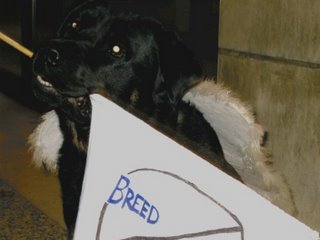 Many say it wouldn't work
Many say it wouldn't work
This is Dana. She's 7 years old. She is the nicest of all the cats I have met. She sleeps on one of the bullies heads. Anyone and anything can pet her and she is the happiest kitty for that. Dana was born a barn cat and was given to me through strange circumstances. She, as a kitten ran up to someone that had visited the farm and jumped in their arms. After that, she wasn't put back on the ground of the barn and came to live with me a short time after.
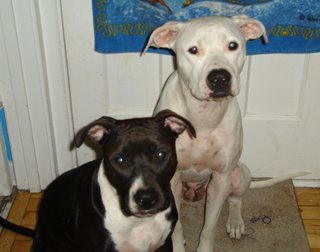
We all know about Brutus and Sadie, but I will reintroduce them for those of you that don't.
Brutus is a little over 2. We got him from a friend that just HAD to breed his bitch. He was an absolute must. We saw him when he was only a week old or so. His mom had 8 puppies and Brutus was the biggest of them all. We would see him every day until it was time to bring him home. A short while after he was brought home, he became terribly sick. We were worried because he was getting sick uncontrolably and I tried every home remedy to stop it, but to no avail. I took him to the vet and he was diagnosed with Parvo. The evil, evil disease that some puppies contract. So, the vet kept him for the weekend and he was treated, cured, and released.
Sadie is a much different story. She was with her sister and lived next door to my friend. She and her sister were in a family with 4 small children that walked them constantly. When they would get tired and try to lie down, the kids would make them walk some more. I don't know how many times I got mad and yelled at the kids to treat their dogs better, but I was looking out for the dogs. Anyways, a short time after the dogs were brought there, the family left the home and left the dogs. Since these were Staffie mixes, I didn't want to call the Humane Society out of fear with the new pit bull ban and there was NO WAY that I was calling Animal Care and Control to report them as strays. They would have been killed instantly. So, I brought them home to my house. I was able to find a home for them, but Sadie's home needed some time before they could take her in. It was a few months, and then I couldn't part with her. She's so special to me. She just couldn't leave me then.

Now there's Lenny. He's 2 and a great pet. I got him as a baby at the pet store that I used to work at. He "apparently" bit the woman in the small animal department, so she was hesitant to show people what a great little guy he was. I brought him home because I felt that he wasn't getting enough interaction there and I could give him all the time in the world at home. Lenny will come for car rides with me in the warmer months of the year. My friend's child, who is now 6 absolutely loves him and wants him to come out whenever we are going anywhere in the car. Lenny is very content to ride on his shoulder, or run around the back seat of the car. He likes, like all rats, to be held and played with all the time. I tried to introduce Lenny to other rats, but that didn't work. He is much happier as a lone rat. I know that doesn't make ANY sence, but it's true. I had a pair of rats that he wanted nothing to do with. He prefers human interaction any day of the week.

Next is Nala. She's almost 2 and a ball of fun. Nala came to me from a friend who couldn't keep her because she only got along with one of the other cats that lived with her. There were 5 cats in total, and Nala was miserable. She knew that I could give her a home and was sure that Nala and Dana would get along great. Well, she was right! Nala LOVES Dana. She even calls for her when Dana isn't in eye sight.

Next is my beautiful Kaori. I have no idea how old she is. A friend of mine has 3 rabbits and I met them and fell in love. I got Kaori from Animal Care and Control. She cost me a whole $5 and I think it was the best $5 that I've ever spent. She's great. I have built her a huge enclosure in the spare room where she spends most of her time running loose, but is locked up at night and while I'm at work. She's one friendly girl and really gets along with all the pets in my home. I haven't introduced the cats to her, but I don't think that I will. She did see Dana while I had her running around in the living room, but they didn't get close to each other.

And last, but certainly not least is Chester. I have no idea how old Chester is either. I adoped him from the Humane Society and brought him home a few weeks ago. He was stuck in the cage there for almost 6 months. He's having a great time at my house. He's got a huge enclosure that he doesn't know what to do with. I put the igloo in there, but I think I might take it out as he is hiding in there most of the time. I think it's probably better for him to be booting around the pen, but I don't like that he hides all the time. I'll proabaly keep the igloo in there for a while longer and see what happens. Before I built him the pen, there was no room in the cage that I had him in for the igloo, so I didn't have it in there.
Well, I think that's enough from me for a while.
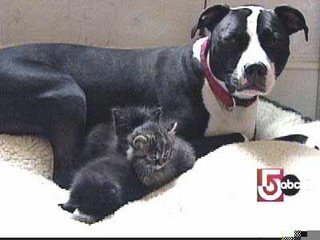 Pit Bull Mothers New Kittens
Pit Bull Mothers New Kittens